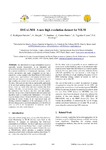DSUALMH-A new high-resolution dataset for NILM

Use this link to cite
http://hdl.handle.net/2183/34142Collections
- Investigación (EPEF) [590]
Metadata
Show full item recordTitle
DSUALMH-A new high-resolution dataset for NILMAuthor(s)
Date
2023-07Citation
Rodriguez-Navarro, C., A. Alcayde, V. Isanbaev, L. Castro-Santos, A. Filgueira-Vizoso, and F.G. Montoya. 2023. “DSUALMH- A New High-Resolution Dataset for NILM,” Renewable Energy and Power Quality Journal 21, 21 (1): 238–43. https://doi.org/10.24084/repqj21.286.
Abstract
[Abstract]: The optimisation of energy consumption requires a reasonably accurate measurement, so an appropriate and advanced monitoring system of the relevant electrical variables in the electrical installations is of paramount importance. In this context, interoperable and highly configurable devices play a crucial role. A clear example is the OpenZMeter (OZM) which is an open source, open hardware, multi-purpose precision smart meter that can measure a wide range of electrical variables at a high sampling rate and provide processed data on power quality. The aim of this work is to show the use and possible applications of the new high sampling frequency data provided by the OZM device, which are much richer and more accurate than those obtained with other low-cost electrical meters. For this purpose, the opensource tool NILMTK has been used and adapted. Likewise, the use of two of the best known and most widely used algorithms such as Combinatorial Optimisation (CO) and the Factorial Hidden Markov Model (FHMM) has been considered, analysing the results obtained in the experimental study and offering a detailed comparison of the performance of the two different disaggregation algorithms using metrics for the different cases, as well as the incorporation of transients, and the comparison with other public Datasets
Editor version
ISSN
2172 038X





